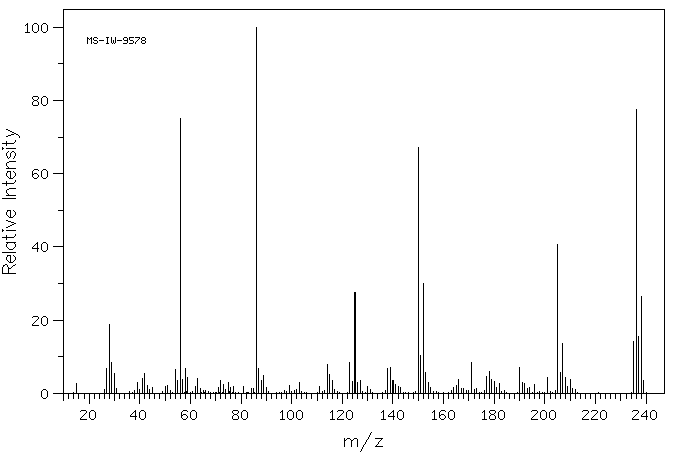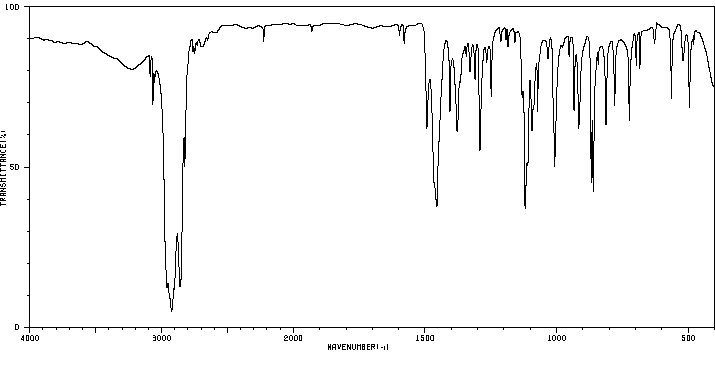2-(4-氯苯基)-2-吗啉乙腈 | 33599-26-7
中文名称
2-(4-氯苯基)-2-吗啉乙腈
中文别名
——
英文名称
α-(4-Chlorophenyl)-4-morpholineacetonitrile
英文别名
2-(4-chlorophenyl)-2-morpholinoacetonitrile;MBF1;(4-chloro-phenyl)-morpholin-4-yl-acetonitrile;2-p-Chlorphenyl-2-morpholinoacetonitril;2-(4-chlorophenyl)-2-morpholin-4-ylacetonitrile
CAS
33599-26-7
化学式
C12H13ClN2O
mdl
MFCD00173106
分子量
236.701
InChiKey
YBUDMLBUDBGODD-UHFFFAOYSA-N
BEILSTEIN
——
EINECS
——
-
物化性质
-
计算性质
-
ADMET
-
安全信息
-
SDS
-
制备方法与用途
-
上下游信息
-
文献信息
-
表征谱图
-
同类化合物
-
相关功能分类
-
相关结构分类
物化性质
-
熔点:76 °C
计算性质
-
辛醇/水分配系数(LogP):2
-
重原子数:16
-
可旋转键数:2
-
环数:2.0
-
sp3杂化的碳原子比例:0.416
-
拓扑面积:36.3
-
氢给体数:0
-
氢受体数:3
安全信息
-
危险等级:IRRITANT
-
海关编码:2934999090
-
储存条件:室温
SDS
反应信息
-
作为反应物:描述:2-(4-氯苯基)-2-吗啉乙腈 在 copper(ll) sulfate pentahydrate 、 sodium hydride 、 1,8-二氮杂双环[5.4.0]十一碳-7-烯 作用下, 以 甲醇 、 二氯甲烷 、 水 、 N,N-二甲基甲酰胺 为溶剂, 反应 15.83h, 生成 3-(p-chlorophenyl)-1H-isochromen-1-one参考文献:名称:3-芳基异香豆素的酰基阴离子化学合成及丁香酚A和Cajanolactone A的合成摘要:3-芳基异香豆素和8-羟基-3-芳基异香豆素的合成新策略通过使用酰基阴离子化学进行初始C-C键形成研究。得到的酮酯和酮内酯作为中间体进行基于促进的分子内环化,以良好的产率得到3-芳基异香豆素。所开发的方法用于合成重要的天然产物 thunberginol A 和 cajanolactone A。DOI:10.1002/ejoc.201403524
-
作为产物:描述:[2-(4-chlorophenyl)-2-morpholin-4-ylethenylidene]azanide 生成 2-(4-氯苯基)-2-吗啉乙腈参考文献:名称:BORDWELL, F. G.;BAUSCH, MARK J.;CHENG, JIN-PEI;CRIPE, THONAS H.;LYNCH, TS+, J. ORG. CHEM., 55,(1990) N, C. 58-63摘要:DOI:
文献信息
-
Synthesis of 4-aroyl-5-nitro-1<i>H</i>-imidazoles and 4-aroyl-5-aminoimidazoles作者:J. Donald Albright、Daniel B. MoranDOI:10.1002/jhet.5570230350日期:1986.5reaction of α-(aryl)-4-morpholineacetonitriles (masked aroyl anion equivalents) with N-protected 4(5)-bromo-5(4)-nitro-1H-imidazoles gave 4-aroyl-5-nitroimidazoles which were reduced to afford 4-aroyl-5-aminoimidazoles.
-
Substituted thio-substituted benzyl-propionyl-L-prolines申请人:American Cyanamid Company公开号:US04226775A1公开(公告)日:1980-10-07This disclosure describes novel substituted .omega.-aroyl(propionyl or butyryl)-L-prolines and the esters and cationic salts thereof which are useful as hypotensive agents in mammals.这份披露描述了新型的取代的ω-芳酰基(丙酰基或丁酰基)-L-脯氨酸及其酯和阳离子盐,它们在哺乳动物中作为降血压剂是有用的。
-
[EN] THIENO-PYRIDINONE DERIVATIVES AS KINASE INHIBITORS<br/>[FR] UTILISATION DE DERIVES DE THIENO-PYRIDONONE COMME INHIBITEURS DE KINASES申请人:CELLTECH R&D LTD公开号:WO2005042540A1公开(公告)日:2005-05-12A series of thieno[2,3-b]pyridin-6(7H)-one derivatives, substituted in the 3-position by an arylcarbonyl or heteroarylcarbonyl moiety, being inhibitors of p38 MAP kinase, are accordingly of use in medicine, for example in the treatment and/or prevention of immune or inflammatory disorders.
-
Efficient Co(ii) heterogeneously catalysed synthesis of α-aminonitriles at room temperature via Strecker-type reactions作者:Fatemeh Rajabi、Sara Ghiassian、Mohammad Reza SaidiDOI:10.1039/c0gc00047g日期:——An environmentally friendly and highly active mesoporous Co(II) complex on mesoporous SBA-15 material could be used as an easily recoverable catalyst for the synthesis of α-aminonitriles from a wide range of aldehydes/ketones and primary or secondary amines with good to excellent conversions yields at room temperature under solventless conditions. The catalyst can be recovered by simple filtration and could be reused at least 10 times without loss of catalytic activity.一种环境友好且活性高的介孔Co(II)配合物负载于介孔SBA-15材料上,可作为易于回收的催化剂,用于在无溶剂条件下室温下从广泛范围的醛/酮和伯或仲胺合成α-氨基腈,并具有优良至极佳的转化产率。通过简单过滤即可回收该催化剂,并且至少可重复使用10次而不会损失其催化活性。
-
Heterogeneously catalysed Strecker-type reactions using supported Co(ii) catalysts: microwave vs. conventional heating作者:Fatemeh Rajabi、Saghar Nourian、Sara Ghiassian、Alina M. Balu、Mohammad Reza Saidi、Juan Carlos Serrano-Ruiz、Rafael LuqueDOI:10.1039/c1gc15741h日期:——α-aminonitriles could be efficiently prepared from various aldehydes/ketones and primary or secondary amines using a highly active and stable Co(II) complex supported on different mesoporous supports at both room temperature and low temperature microwave irradiation under solventless conditions. Catalysts were also highly reusable under the investigated reaction conditions and could be reused at least 10 times
表征谱图
-
氢谱1HNMR
-
质谱MS
-
碳谱13CNMR
-
红外IR
-
拉曼Raman
-
峰位数据
-
峰位匹配
-
表征信息
同类化合物
(βS)-β-氨基-4-(4-羟基苯氧基)-3,5-二碘苯甲丙醇
(S,S)-邻甲苯基-DIPAMP
(S)-(-)-7'-〔4(S)-(苄基)恶唑-2-基]-7-二(3,5-二-叔丁基苯基)膦基-2,2',3,3'-四氢-1,1-螺二氢茚
(S)-盐酸沙丁胺醇
(S)-3-(叔丁基)-4-(2,6-二甲氧基苯基)-2,3-二氢苯并[d][1,3]氧磷杂环戊二烯
(S)-2,2'-双[双(3,5-三氟甲基苯基)膦基]-4,4',6,6'-四甲氧基联苯
(S)-1-[3,5-双(三氟甲基)苯基]-3-[1-(二甲基氨基)-3-甲基丁烷-2-基]硫脲
(R)富马酸托特罗定
(R)-(-)-盐酸尼古地平
(R)-(-)-4,12-双(二苯基膦基)[2.2]对环芳烷(1,5环辛二烯)铑(I)四氟硼酸盐
(R)-(+)-7-双(3,5-二叔丁基苯基)膦基7''-[((6-甲基吡啶-2-基甲基)氨基]-2,2'',3,3''-四氢-1,1''-螺双茚满
(R)-(+)-7-双(3,5-二叔丁基苯基)膦基7''-[(4-叔丁基吡啶-2-基甲基)氨基]-2,2'',3,3''-四氢-1,1''-螺双茚满
(R)-(+)-7-双(3,5-二叔丁基苯基)膦基7''-[(3-甲基吡啶-2-基甲基)氨基]-2,2'',3,3''-四氢-1,1''-螺双茚满
(R)-(+)-4,7-双(3,5-二-叔丁基苯基)膦基-7“-[(吡啶-2-基甲基)氨基]-2,2”,3,3'-四氢1,1'-螺二茚满
(R)-3-(叔丁基)-4-(2,6-二苯氧基苯基)-2,3-二氢苯并[d][1,3]氧杂磷杂环戊烯
(R)-2-[((二苯基膦基)甲基]吡咯烷
(R)-1-[3,5-双(三氟甲基)苯基]-3-[1-(二甲基氨基)-3-甲基丁烷-2-基]硫脲
(N-(4-甲氧基苯基)-N-甲基-3-(1-哌啶基)丙-2-烯酰胺)
(5-溴-2-羟基苯基)-4-氯苯甲酮
(5-溴-2-氯苯基)(4-羟基苯基)甲酮
(5-氧代-3-苯基-2,5-二氢-1,2,3,4-oxatriazol-3-鎓)
(4S,5R)-4-甲基-5-苯基-1,2,3-氧代噻唑烷-2,2-二氧化物-3-羧酸叔丁酯
(4S,4''S)-2,2''-亚环戊基双[4,5-二氢-4-(苯甲基)恶唑]
(4-溴苯基)-[2-氟-4-[6-[甲基(丙-2-烯基)氨基]己氧基]苯基]甲酮
(4-丁氧基苯甲基)三苯基溴化磷
(3aR,8aR)-(-)-4,4,8,8-四(3,5-二甲基苯基)四氢-2,2-二甲基-6-苯基-1,3-二氧戊环[4,5-e]二恶唑磷
(3aR,6aS)-5-氧代六氢环戊基[c]吡咯-2(1H)-羧酸酯
(2Z)-3-[[(4-氯苯基)氨基]-2-氰基丙烯酸乙酯
(2S,3S,5S)-5-(叔丁氧基甲酰氨基)-2-(N-5-噻唑基-甲氧羰基)氨基-1,6-二苯基-3-羟基己烷
(2S,2''S,3S,3''S)-3,3''-二叔丁基-4,4''-双(2,6-二甲氧基苯基)-2,2'',3,3''-四氢-2,2''-联苯并[d][1,3]氧杂磷杂戊环
(2S)-(-)-2-{[[[[3,5-双(氟代甲基)苯基]氨基]硫代甲基]氨基}-N-(二苯基甲基)-N,3,3-三甲基丁酰胺
(2S)-2-[[[[[((1S,2S)-2-氨基环己基]氨基]硫代甲基]氨基]-N-(二苯甲基)-N,3,3-三甲基丁酰胺
(2S)-2-[[[[[[((1R,2R)-2-氨基环己基]氨基]硫代甲基]氨基]-N-(二苯甲基)-N,3,3-三甲基丁酰胺
(2-硝基苯基)磷酸三酰胺
(2,6-二氯苯基)乙酰氯
(2,3-二甲氧基-5-甲基苯基)硼酸
(1S,2S,3S,5S)-5-叠氮基-3-(苯基甲氧基)-2-[(苯基甲氧基)甲基]环戊醇
(1S,2S,3R,5R)-2-(苄氧基)甲基-6-氧杂双环[3.1.0]己-3-醇
(1-(4-氟苯基)环丙基)甲胺盐酸盐
(1-(3-溴苯基)环丁基)甲胺盐酸盐
(1-(2-氯苯基)环丁基)甲胺盐酸盐
(1-(2-氟苯基)环丙基)甲胺盐酸盐
(1-(2,6-二氟苯基)环丙基)甲胺盐酸盐
(-)-去甲基西布曲明
龙蒿油
龙胆酸钠
龙胆酸叔丁酯
龙胆酸
龙胆紫-d6
龙胆紫








